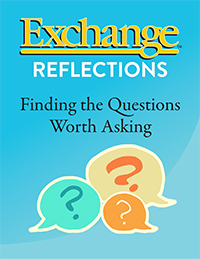ExchangeEveryDay Past Issues
 << Previous Issue
| View Past Issues | | Next Issue >>
<< Previous Issue
| View Past Issues | | Next Issue >> -Rachelle Doorley, Maker and Educator
“Ask three questions about anything you are doing in the classroom: What are you doing? Why are you doing it? Who is it for? When you ask these questions about product art, the answers usually have little to do with child development,” writes Elizabeth Richards, in an article that forms the basis of the latest Exchange Reflections, “Art that Celebrates the Process.”
According to NAEYC, product art involves following a sample or set of instructions, with a finished product in mind, while process art includes these characteristics:
• The art is focused on the experience and on exploration of techniques, tools, and materials
• The experience is relaxing or calming
• The art is entirely the children’s own
• The art experience is a child’s choice
• Ideas are not readily available online
Process art advocate Rachelle Doorley suggests, “If we want our children to thrive in the highly unknown future, they’ll be best equipped if they can learn to think for themselves. These higher-level thinking skills won’t develop through copying or following directions, but through the processes of problem-posing that goes along with invention and experimentation.”
In “Art that Celebrates the Process,” Richards puts this in concrete terms, “If a teacher is controlling available types and quantities of materials, such as how much glue children may use, learning is restricted. It is the very act of experimenting that teaches them how much glue is too much, which materials they need to create their own vision, or what the word sticky means.”
Share your thoughts about product art and process art in the comments or spark a discussion among your colleagues with the latest Exchange Reflections on Richard's article.
 |
ExchangeEveryDay
Delivered five days a week containing news, success stories, solutions, trend reports, and much more.
What is ExchangeEveryDay?
ExchangeEveryDay is the official electronic newsletter for Exchange Press. It is delivered five days a week containing news stories, success stories, solutions, trend reports, and much more.


Comments (2)
Displaying All 2 CommentsTouro College Graduate School of Education
Valley Stream, NY, United States
I agree with the authors. I believe the focus of product centered art stems from the pressure to comply with data proving what children are "learning" and can follow directions. It also comes from parents who want to have something to hang on the fridge. It has to "look pretty" to please parents so directions, samples and control of materials give the teacher a sense of control. For example, Teachers can support children's experimentation, expression, and sense of autonomy with choices of materials, using cups with lids so things don't get out of hand.
Individual consultant
Dhaka, Bangladesh
I found the write-up very much important and would like to be sure that the questions to the children will be very much open which will not scare them, they are encouraged and will enjoy the full freedom of answering, will not distract the process they were following, the questions will not expect a 'product' in mind and will not be guiding in nature, etc. etc.
Post a Comment